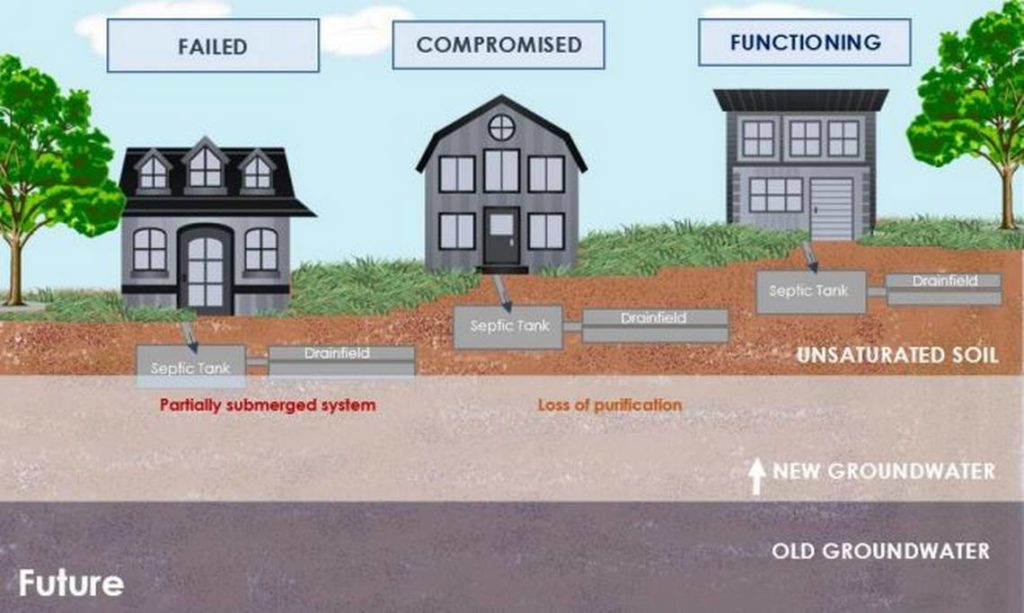Miami-Dade has tens of thousands of septic tanks, and a new report reveals most are already malfunctioning — the smelly and unhealthy evidence of which often ends up in people’s yards and homes. It’s a billion-dollar problem that climate change is making worse.
As sea level rise encroaches on South Florida, the Miami-Dade County study shows that thousands more residents may be at risk — and soon. By 2040, 64 percent of county septic tanks (more than 67,000) could have issues every year, affecting not only the people who rely on them for sewage treatment, but the region’s water supply and the health of anyone who wades through floodwaters.
“That’s a huge deal for a developed country in 2019 to have half of the septic tanks not functioning for part of the year,” said Miami Waterkeeper Executive Director Rachel Silverstein. “That is not acceptable.”
Septic tanks require a layer of dirt underneath to do the final filtration work and return the liquid waste back to the aquifer. Older rules required one foot of soil, but newer regulations call for double that. In South Florida, there’s not that much dirt between the homes above ground and the water below.

Miami-Dade County
High tides or heavy rains can push feces-filled water elsewhere, including King Tide floodwaters — as pointed out in a 2016 study from Florida International University and NOAA — or possibly the region’s drinking supply.
In total, there are about 108,000 properties within the county that still use septic, about 105,000 of which are residential. The vast majority (more than 65,000) of the septic systems are in unincorporated Miami-Dade.
Miami Gardens, North Miami Beach, Palmetto Bay and Pinecrest have the most of any city, at about 5,000 each.
Some of those cities will see hundreds more septic tanks experiencing yearly failures within the decade, like North Miami Beach, which has 2,780 homes with septic tanks with periodic issues now. By 2030, that is expected to jump to 3,751.
The report did not forecast past 2040, when the region is expecting around 15 inches of sea rise, a number that is predicted to creep exponentially upward over the decades.
“The best response is sewer extension, but obviously that infrastructure takes quite a bit of planning and time,” said Katherine Haggman, the county’s resilience program manager.
“And money,” County Chief Resilience Officer James Murley added.
Ripping out every septic tank and laying down new pipes to connect the homes to the county’s sewer system won’t be cheap. The latest estimate put the price tag at $3.3 billion.
“Who has that?” said Commissioner Rebeca Sosa, who called for the study. “We need to act as fast as possible. We need to get as much assistance as we can from the federal government, from the state.”
That $3.3 billion price tag doesn’t cover commercial properties, an estimated $230 million cost, Yoder said. The county’s current general obligation bond includes $126 million to extend sewer services to businesses. Yoder said the plans are in the design phase.
For now, anyone who wants to connect their property to the county’s sewer system has to pay out of pocket. The report cites the average price as $15,000, but Yoder estimated that in septic-reliant areas like Pinecrest, it could cost around $50,000 per home to tap into the sewer system.
That’s cash most residents don’t have on hand, Haggman said, which is why the county is exploring other ways to help residents out.
“We have options, but I think that’s a good area for more conversation,” she said.
Besides borrowing more money with another bond, the report pointed out the county’s best options would be continuing to collect the per-home fee or establishing special taxing districts and spreading the cost into a neighborhood.
Silverstein said the findings raise significant concerns about impacts from septic tanks not just in 20 years, but now.
“Clearly the county is facing a major system failure here. Septic tanks are already compromised and will continue to be even more comprised with sea level rise and they need to take rapid action to address this and make the system more resilient,” she said.
Miami Herald Staff Writer Jenny Staletovich contributed to this story.
“The Invading Sea” is a collaboration of four South Florida media organizations — the South Florida Sun Sentinel, Miami Herald, Palm Beach Post and WLRN Public Media.



